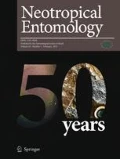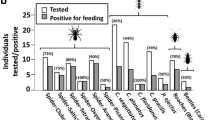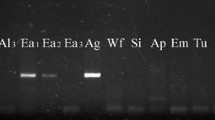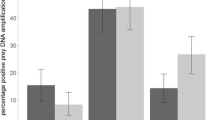Abstract
Diaphorina citri Kuwayama is the vector of the pathogenic bacteria Candidatus Liberibacter spp., the causative agent of Huanglongbing (HLB), the most serious disease of citrus worldwide. Because predatory insects have been historically neglected in biological control programs for D. citri, the impact of generalist predators on D. citri population densities is little understood. A useful tool to evaluate the dynamics of predator-prey interactions is molecular analysis of predators’ gut content. We constructed a specific molecular marker to detect D. citri DNA in the gut content of predator insects, for use in estimating the predation rate of field-collected predators in citrus orchards on D. citri. Bioassays of the DNA half-life detection time were carried out with two predatory species, the ladybird beetle Hippodamia convergens Guérin-Méneville and the lacewing Chrysoperla externa (Hagen). The D. citri DNA half-life detection time (DT50) was 6.11 h for H. convergens and 5.46 h for C. externa. One hundred and seven field-collected predators were used for gut-content analysis (52 larvae/adults of ladybirds and 55 larvae of lacewings). The assays showed that 17.3% of ladybirds but no lacewings tested positive for D. citri DNA. These results show that generalist predators can contribute to biological control of D. citri and should be considered for use in pest management programs in citrus orchards.



Similar content being viewed by others
References
Belasque Júnior J, Filho AB, Bassanezi RB et al (2009) Base científica para a erradicação de plantas sintomáticas e assintomáticas de Huanglongbing (HLB, Greening) visando o controle efetivo da doença. Trop Plant Pathol 34:137–145. https://doi.org/10.1590/S1982-56762009000300001
Bové JM (2006) Huanglongbing: a destructive, newly-emerging, century-old disease of citrus. J Plant Pathol 88:7–37. https://doi.org/10.4454/jpp.v88i1.828
Boykin LM, De Barro P, Hall DG et al (2012) Overview of worldwide diversity of Diaphorina citri Kuwayama mitochondrial cytochrome oxidase 1 haplotypes: two Old World lineages and a New World invasion. Bull Entomol Res 102:573–582. https://doi.org/10.1017/S0007485312000181
Chien CC, Chu YI, Ku SC (1991) Biological control of citrus psyllid, Diaphorina citri in Taiwan. II. Evaluation of Tamarixia radiata and Diaphorencyrtus diaphorinae for the control of Diaphorina citri. Chinese J Entomol 11:25–38
Chong J-H, Roda AL, Mannion CM (2010) Density and natural enemies of the Asian citrus psyllid, Diaphorina citri (Hemiptera: Psyllidae), in the residential landscape of southern Florida. J Agric Urban Entomol 27:33–49. https://doi.org/10.3954/11-05.1
Coletta-Filho HD, Targon MLPN, Takita MA et al (2004) First report of the causal agent of Huanglongbing (“Candidatus Liberibacter asiaticus”) in Brazil. Plant Dis 88:1382. https://doi.org/10.1094/PDIS.2004.88.12.1382C
Corrêa AS, Orlando de Oliveira L, Braga LS, Guedes RNC (2013) Distribution of the related weevil species Sitophilus oryzae and S. zeamais in Brazil. Insect Sci 20:763–770. https://doi.org/10.1111/j.1744-7917.2012.01559.x
Doyle JJ, Doyle JL (1987) A rapid DNA isolation procedure for small quantities of fresh leaf tissue. Phytochem Bull 19:11–15
Feng Y, Zhou ZX, An MR et al (2018) Conspecific and heterospecific interactions modify the functional response of Harmonia axyridis and Propylea japonica to Aphis citricola. Entomol Exp Appl 166:873–882. https://doi.org/10.1111/eea.12742
Ferronato P, Woch AL, Soares PL et al (2019) A phylogeographic approach to the Drosophila suzukii (Diptera: Drosophilidae) invasion in Brazil. J Econ Entomol 112:425–433. https://doi.org/10.1093/jee/toy321
Furlong MJ (2015) Knowing your enemies: integrating molecular and ecological methods to assess the impact of arthropod predators on crop pests. Insect Sci 22:6–19. https://doi.org/10.1111/1744-7917.12157
Gordon RD (1980) The tribe Azyini (Coleoptera: Coccinellidae): historical review and taxonomic revision. Am Entomol Soc 106:149–203
Grafton-Cardwell EE, Lukasz LS, Stansly PA (2013) Biology and management of Asian citrus psyllid, vector of the huanglongbing pathogens. Annu Rev Entomol 58:413–432
Greenstone MH, Payton ME, Weber DC, Simmons AM (2014) The detectability half-life in arthropod predator-prey research: what it is, why we need it, how to measure it, and how to use it. Mol Ecol 23:3799–3813. https://doi.org/10.1111/mec.12552
Guidolin AS, Fresia P, Cônsoli FL (2014) The genetic structure of an invasive pest, the Asian citrus psyllid Diaphorina citri (Hemiptera: Liviidae). PLoS One 9:e115749. https://doi.org/10.1371/journal.pone.0115749
Hagler JR, Naranjo SE (1997) Measuring the sensitivity of an indirect predator gut content ELISA: detectability of prey remains in relation to predator species, temperature, time, and meal size. Biol Control 9:112–119. https://doi.org/10.1006/bcon.1997.0521
Halbert SE, Manjunath KL (2004) Asian citrus psyllids (Sternorrhyncha: Psyllidae) and greening disease in citrus: a literature review and assessment of risk in Florida. Florida Entomol 87:330–353. https://doi.org/10.1653/0015-4040(2004)087[0330:ACPSPA]2.0.CO;2
Hall DG (2008) Biology, history and world status of Diaphorina citri. In: I Taller Internacional sobre Huanglongbing de los cítricos (Candidatus Liberibacter spp) y el psílido asiático de los cítricos (Diaphorina citri). Hermosillo, Sonora, Mexico, pp 1–11
Hebert PDN, Cywinska A, Ball SL, DeWaard JR (2003) Biological identifications through DNA barcodes. Proc R Soc B Biol Sci 270:313–321. https://doi.org/10.1098/rspb.2002.2218
Hoddle MS (2012) Foreign exploration for natural enemies of Asian citrus psyllid, Diaphorina citri (Hemiptera: Psyllidae), in the Punjab of Pakistan for use in a classical biological control program in California USA. Pakistan Entomol 34:1–5
Hoogendoorn M, Heimpel GE (2001) PCR-based gut content analysis of insect predators: using ribosomal ITS-1 fragments from prey to estimate predation frequency. Mol Ecol 10:2059–2067. https://doi.org/10.1046/j.1365-294X.2001.01316.x
Hosseini R, Schmidt O, Keller MA (2008) Factors affecting detectability of prey DNA in the gut contents of invertebrate predators: a polymerase chain reaction-based method. Entomol Exp Appl 126:194–202. https://doi.org/10.1111/j.1570-7458.2007.00657.x
Jacobsen SK, Sigsgaard L, Hansen K, Harwood JD, Chapman EG, Hurtado MA, Jensen AB (2019) Generalist predator contributions to the control of Tetranychus urticae in strawberry crops documented by PCR-based gut content analysis. Exp Appl Acarol 77:133–143. https://doi.org/10.1007/s10493-019-00351-x
Kenis M, Adriaens T, Brown P et al (2010) Impact of Harmonia axyridis on European ladybirds: which species are most at risk? IOBC/WPRS Bull 58:57–59
King RA, Read DS, Traugott M, Symondson WOC (2008) Molecular analysis of predation: a review of best practice for DNA-based approaches. Mol Ecol 17:947–963. https://doi.org/10.1111/j.1365-294X.2007.03613.x
Knighten C, Redding J, Feiber D, Compton E (2005) US Department of Agriculture and Florida Department of Agriculture confirm detection of citrus greening. Press release. http://www.doacs.state.fl.us/press/2005/09022005_2.html
Koester M, Gergs R (2017) Laboratory protocol for genetic gut content analyses of aquatic macroinvertebrates using group-specific rDNA primers. J Vis Exp 128:e56132. https://doi.org/10.3791/56132
Kondo T, González FG, Tauber C et al (2015) A checklist of natural enemies of Diaphorina citri Kuwayama (Hemiptera: Liviidae) in the department of Valle del Cauca, Colombia and the world. Insecta Mundi 0457:1–14
Krehenwinkel H, Kennedy S, Pekár S, Gillespie RG (2017) A cost-efficient and simple protocol to enrich prey DNA from extractions of predatory arthropods for large-scale gut content analysis by Illumina sequencing. Methods Ecol Evol 8:126–134. https://doi.org/10.1111/2041-210X.12647
Labrie G, Lucas É, Coderre D (2006) Can developmental and behavioral characteristics of the multicolored Asian lady beetle Harmonia axyridis explain its invasive success? Biol Invasions 8:743–754. https://doi.org/10.1007/s10530-005-3428-6
Lantero E, Matallanas B, Pascual S, Callejas C (2018) PCR species-specific primers for molecular gut content analysis to determine the contribution of generalist predators to the biological control of the vector of Xylella fastidiosa. Sustain 10:4–11. https://doi.org/10.3390/su10072207
Lavagnini TC, Morales AC, Freitas S (2015) Population genetics of Chrysoperla externa (Neuroptera: Chrysopidae) and implications for biological control. Braz J Biol 75:878–885. https://doi.org/10.1590/1519-6984.02014
Legaspi JC, Legaspi JR. BC, Ciomperlik MA, Meagher JR. RL (1996) Evaluation of Serangium parcesetosum (Coleoptera: Coccinellidae) as a biological control agent of the silverleaf whitefly (Homoptera: Aleyrodidae). Environ Entomol 25:1421–1427. https://doi.org/10.1093/ee/25.6.1421
Masetti A, Magagnoli S, Lami F, Lanzoni A, Burgio G (2018) Long term changes in the communities of native ladybirds in Northern Italy: impact of the invasive species Harmonia axyridis (Pallas). BioControl 63:665–675. https://doi.org/10.1007/s10526-018-9891-7
Michaud JP (2002a) Classical biological control: a critical review of recent programs against citrus pests in Florida. Ann Entomol Soc Am 95:531–540. https://doi.org/10.1603/0013-8746(2002)095[0531:cbcacr]2.0.co;2
Michaud JP (2002b) Biological control of Asian citrus psyllid, Diaphorina citri (Hemiptera: Psyllidae) in Florida: a preliminary report. Entomol News 113:216–222
Milléo J, Meira WV (2012) Morfologia dos Coccinellini (Coleoptera: Coccinellidae) depositados na coleção entomológica dos Campos Gerais do Paraná, Ponta Grossa, Paraná. EntomoBrasilis 5:146–463
Milléo J, Fernandes FS, Godoy WAC (2014) Comparative demography of the exotic Harmonia axyridis with other aphidophagous coccinellids reared on artificial diet. Pesqui Agropecuária Bras 49:1–10. https://doi.org/10.1590/S0100-204X2014000100001
Namaghi HS, Husseini M (2009) The effects of collection methods on species diversity of family Syrphidae (Diptera) in Neyshabur 11: 521-526. J Agr Sci Tech, Iran
Panni S, Pizzolotto R (2018) Fast molecular assay to detect the rate of decay of Bactrocera oleae (Diptera: Tephritidae) DNA in Pterostichus melas (Coleoptera: Carabidae) gut contents. Appl Entomol Zool 53:425–431. https://doi.org/10.1007/s13355-018-0564-x
Parra JRP, Alves GR, Diniz AJF, Vieira JM (2016) Tamarixia radiata (Hymenoptera: Eulophidae) × Diaphorina citri (Hemiptera: Liviidae): mass rearing and potential use of the parasitoid in Brazil. J Integr Pest Manag 7:1–11. https://doi.org/10.1093/jipm/pmw003
Pell JK, Baverstock J, Roy HE, Ware RL, Majerus MEN (2008) Intraguild predation involving Harmonia axyridis: a review of current knowledge and future perspectives. Biol Control 53:147–168. https://doi.org/10.1007/978-1-4020-6939-0_10
Pluke RWH, Qureshi JA, Stansly PA (2008) Citrus flushing patterns, Diaphorina citri (Hemiptera: Psyllidae) populations and parasitism by Tamarixia radiata (Hymenoptera: Eulophidae) in Puerto Rico. Florida Entomol 91:36–42
Pons J (2006) DNA‐based identification of preys from non‐destructive, total DNA extractions of predators using arthropod universal primers. Mol Ecol Notes 6:623–626
Riddick EW (2017) Spotlight on the positive effects of the ladybird Harmonia axyridis on agriculture. BioControl 62:319–330. https://doi.org/10.1007/s10526-016-9758-8
Rozen S, Skaletsky H (2000) Primer3 on the WWW for general users and for biologist programmers. In: Misener S, Krawetz SA (eds) Bioinformatics methods and protocols, Methods in Molecular Biology vol, vol 132. Humana Press, Totowa, NJ, pp 365–386
SAS Institute Inc. (2004) SAS/STAT® 9.1 Users guide, version 9. SAS Institute Inc., Cary, NC
Sheppard SK, Harwood JD (2005) Advances in molecular ecology: tracking trophic links through predator–prey food‐webs. Funct Ecol 19:751–762
Souza B, Carvalho CF (2002) Population dynamics and seasonal occurrence of adults of Chrysoperla externa (Hagen, 1861)(Neuroptera: Chrysopidae) in a citrus orchard in southern Brazil. Acta Zool Acad Sci Hung 48:301–310
Stange LA (2000) The green lacewings of Florida (Neuroptera: Chrysopidae). 1. Genera. Entomol Circ No 400 Fla. Dept. Agric. & Consumer Serv: 2–5.
Staudacher K, Jonsson M, Traugott M (2016) Diagnostic PCR assays to unravel food web interactions in cereal crops with focus on biological control of aphids. J Pest Sci 89:281–293. https://doi.org/10.1007/s10340-015-0685-8
Stephens DW, Krebs JR (1986) Foraging theory. Princeton University Press, Princeton
Symondson WOC, Sunderland KD, Greenstone MH (2002) Can generalist predators be effective biocontrol agents? Annu Rev Entomol 47:561–594. https://doi.org/10.1146/annurev.ento.47.091201.145240
Texeira DC, Ayres J, Kitajima EW et al (2005) First report of a Huanglongbing-like disease of citrus in Sao Paulo state, Brazil and association of a new Liberibacter species, “Candidatus Liberibacter americanus”, with the disease. Plant Dis 89:107.1. https://doi.org/10.1094/PD-89-0107A
Traugott M, Bell JR, Raso L et al (2012) Generalist predators disrupt parasitoid aphid control by direct and coincidental intraguild predation. Bull Entomol Res 102:239–247. https://doi.org/10.1017/S0007485311000551
Weber DC, Lundgren JG (2009) Detection of predation using qPCR: effect of prey quantity, elapsed time, chaser diet, and sample preservation on detectable quantity of prey DNA. J Insect Sci 9:1–12. https://doi.org/10.1673/031.009.4101
Acknowledgments
We thank Geraldo Carvalho who provided lacewing eggs, and the Andrade Sun Farms Agrocomercial for providing the area in Mogi Mirim for this study.
Funding
This study was supported by the Fundação de Amparo à Pesquisa do Estado de São Paulo FAPESP (grant #2018/02317-5 to ASC and PY), the Coordenação de Aperfeiçoamento de Pessoal de Nível Superior – Brasil (CAPES) – Finance Code 001 (fellowship to FN and PF), and the Conselho Nacional de Desenvolvimento Científico e Tecnológico – CNPq (fellowships #311465/2018-8 to ASC and #141076/2018-6 to DHM).
Author information
Authors and Affiliations
Contributions
FN, PF, and ASC conceived and designed the study; FN, DHM, GR, and PF collected the data; ASC and PY provided reagents and analytical apparatus; FN and ASC conducted data analyses; and FN, DHM, and ASC wrote the manuscript. All authors read, corrected, and approved the manuscript.
Corresponding author
Additional information
Edited by Herbert Siqueira – UFRPE
Publisher’s Note
Springer Nature remains neutral with regard to jurisdictional claims in published maps and institutional affiliations.
Electronic supplementary material
ESM 1
(DOCX 17 kb)
Rights and permissions
About this article
Cite this article
Nanini, F., Maggio, D.H., Ferronato, P. et al. Molecular Marker to Identify Diaphorina citri (Hemiptera: Liviidae) DNA in Gut Content of Predators. Neotrop Entomol 48, 927–933 (2019). https://doi.org/10.1007/s13744-019-00721-5
Received:
Accepted:
Published:
Issue Date:
DOI: https://doi.org/10.1007/s13744-019-00721-5




